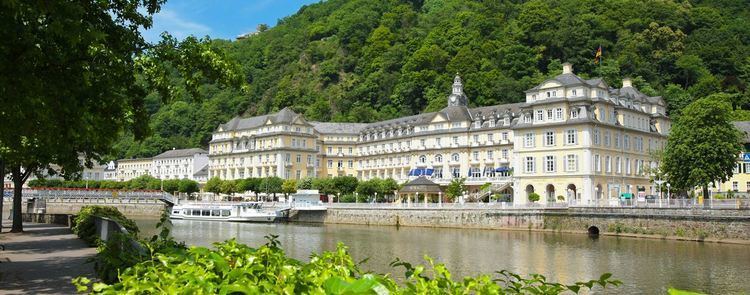Time zone CET/CEST (UTC+1/+2) Area 15.36 km² Population 9,216 (31 Dec 2008) Dialling code 02603 | Municipal assoc. Bad Ems Postal codes 56130 Local time Tuesday 12:16 AM Postal code 56130 | |
 | ||
Weather 7°C, Wind SW at 16 km/h, 81% Humidity | ||
Bad ems an der lahn
Bad Ems is a town in Rheinland Pfalz, Germany. It is the county seat of the Rhein-Lahn rural district and is well known as a bathing resort on the river Lahn. Bad Ems is the seat of the Verbandsgemeinde ("collective municipality") Bad Ems.
Contents
- Bad ems an der lahn
- Map of 56130 Bad Ems Germany
- 364 emser therme gmbh bad ems
- Geography
- History
- Mining
- Mineral springs
- Economy
- International relations
- Sons and daughters of the town
- Personalities who are associated with the city
- References
Map of 56130 Bad Ems, Germany
364 emser therme gmbh bad ems
Geography
The town is built on both sides of the River Lahn, the natural border between the Taunus and the Westerwald, two parts of the Rhenish Slate Mountains. The town and its outer districts are also within the Nassau Nature Reserve.
The town is linked to a view point at the Bismarckturm (Bismarck Tower) by the Kurwaldbahn funicular railway. Bad Ems station lies on the Lahn Valley Railway.
History
In Roman times, a castle was built at Bad Ems as part of the Upper Germanic Limes, but today not much of the structure remains. In the woods around the town, however, there are distinct traces of the former Roman border.
The town was first mentioned in official documents in 880 and received its town charter in 1324. The Counts of Nassau and Katzenelnbogen rebuilt the bath. The high noble Counts loved to use it inviting friends. Days in the bath were often days with musicians and all kinds of food even swimming in the pool. In the 17th and 18th centuries it was considered one of Germany's most famous bathing resorts. It reached its heyday in the 19th century when it welcomed visitors from all over the world and became the summer residence of various European monarchs and artists, including Kaiser Wilhelm I of Germany, Tsars Nicholas I and Alexander II of Russia, Richard Wagner, Fyodor Dostoevsky and Vasili Vasilyevich Vereshchagin, etc.
In 1870 the town, then part of Prussian Hesse-Nassau, became famous as the place where the Ems Dispatch originated, instigating the Franco-Prussian War.
In 1876, in the Haus Vier Türme (Four Tower House), the Ems Edict was signed by Alexander II of Russia, banning the use of the Ukrainian language. Today, a monument at the spot commemorates this historical event.
Mining
In the 19th and 20th centuries a lot of mining for metal ores took place in the town, concentrated on lead, silver, zinc and copper. The Romans had already dug for ores using open cast mining, which continued throughout the Middle Ages. The many indentations on Blöskopf Hill bear witness to this period of history. As time went by, the method changed from open cast mining to underground mining with tunnels and shafts. Mining of this kind is first mentioned in a document dated 1158, and it continued on into the 18th century, although with long interruptions.
The advent of the Industrial Revolution led to the expansion of the mine, which from 1871 operated under the name of "Emser Blei- und Silberwerk AG" (Bad Ems Lead and Silver Works, Inc.). In 1909 the company was taken over by what later became the 'Stolberger Zink AG" (Stolberg Zinc Inc.) and mining continued until the end of the Second World War brought things to a halt in 1945. After the war, the mine no longer received any subsidies, but until 1959, stockpiled ore and ore from other mines were sorted at the central preparation plant in Silberau. Today, the mine is still known as "Mercur", the collective name for various individual pits.
Since 1996, the mine has been set up as a museum. In four different exhibition rooms, the visitors can find information on the development and the meaning of ore mining in the region. The first exhibition room is dedicated to the pre-industrial mining. You can see, among others, finds from old galleries and tunnels. In the second room, the industrial period of mining is being presented. The third room gives information on the social aspect of mining in Bad Ems. Here, you are being informed on housing, mining unions, income and also punishments for poorly performed work. Finally, the last room shows a collection of minerals and different types of ore.
Mineral springs
Natural Ems salt is being produced from local mineral water.
Economy
Industry in Bad Ems is mainly limited to companies related to its spa status, but nonetheless fairly varied, including medicine, electrical engineering and tourism.
International relations
Bad Ems is twinned with:
